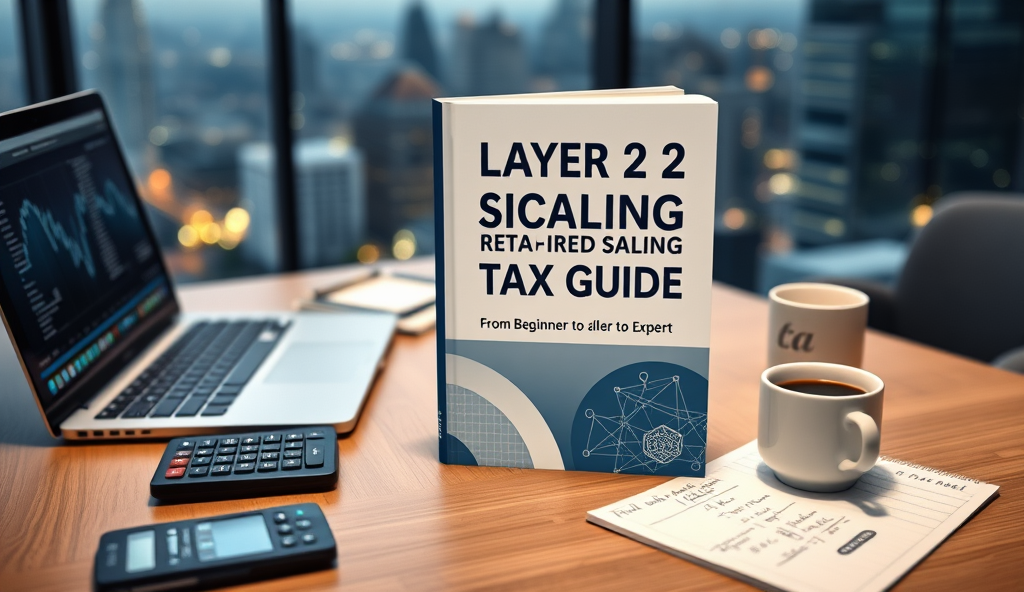Introduction to Layer 2 Scaling and Its Impact on Cryptocurrency Taxes
Layer 2 scaling solutions like Optimism and Arbitrum process transactions off-chain, reducing Ethereum’s congestion while introducing unique tax implications for investors. These protocols bundle multiple transactions into single settlements, creating complex reporting requirements for capital gains and fee deductions.
For example, a single Layer 2 transaction may involve multiple taxable events when bridging assets or paying network fees, requiring detailed tracking. Tax authorities globally are scrutinizing these transactions, with the IRS updating guidance to include Layer 2 activity in 2023 filings.
Understanding these nuances is critical, as Layer 2 scaling can optimize costs but complicate tax obligations. Next, we’ll explore how different Layer 2 solutions function and their specific tax considerations.
Key Statistics

Understanding Layer 2 Scaling Solutions in Cryptocurrency
Layer 2 scaling solutions like Optimism and Arbitrum process transactions off-chain reducing Ethereum's congestion while introducing unique tax implications for investors.
Layer 2 scaling solutions operate as secondary frameworks built atop blockchains like Ethereum, handling transactions off-chain before settling batches on the mainnet. This architecture significantly improves throughput—Optimism processes 2,000 transactions per second compared to Ethereum’s 15—while inheriting the base layer’s security.
These solutions employ distinct technical approaches, from Optimism’s optimistic rollups to Arbitrum’s fraud proofs, each affecting transaction finality and tax event timing differently. For instance, bridging assets between Layer 1 and Layer 2 often triggers taxable disposals, requiring investors to track cross-chain movements separately.
As tax authorities expand scrutiny to Layer 2 activity, understanding these protocols’ mechanics becomes essential for accurate reporting. Next, we’ll analyze how their fee structures and settlement processes directly impact tax liabilities.
How Layer 2 Scaling Affects Transaction Fees and Tax Reporting
Layer 2 solutions reduce transaction fees by up to 90% compared to Ethereum mainnet but these savings introduce tax complexities—gas fees on Optimism or Arbitrum may still qualify as deductible expenses in jurisdictions like the U.S. or Germany.
Layer 2 solutions reduce transaction fees by up to 90% compared to Ethereum mainnet, but these savings introduce tax complexities—gas fees on Optimism or Arbitrum may still qualify as deductible expenses in jurisdictions like the U.S. or Germany.
Investors must distinguish between network fees (potentially deductible) and protocol-specific costs (often non-deductible), requiring granular transaction categorization.
The timing of fee deductions varies by jurisdiction, with some requiring immediate reporting upon payment while others allow deferral until settlement completes on Layer 1. For example, Polygon’s checkpoint system batches transactions hourly, creating mismatches between when fees are paid and when they’re recorded on Ethereum.
These fee structures directly influence capital gains calculations, particularly when moving assets between layers—a $10 bridging fee could alter cost basis by 2% for a $500 transfer. Next, we’ll examine how these dynamics apply specifically to WordPress platforms integrating Layer 2 solutions.
Tax Implications of Using Layer 2 Scaling on WordPress Platforms
Investors must distinguish between Layer 2 transaction fees and mainnet settlement costs as tax authorities may treat them differently—for example Optimism’s fee structure could be classified as an investment expense in Canada but as a cost basis adjustment in Australia.
WordPress plugins leveraging Layer 2 solutions like Arbitrum or Optimism inherit their tax complexities, particularly when processing crypto payments or NFT transactions—platforms must track whether gas fees qualify as deductible business expenses or operational costs. For instance, WooCommerce stores accepting payments via Polygon may need to reconcile hourly checkpoint delays with real-time sales reporting for accurate tax filings.
The jurisdictional mismatch in fee timing becomes critical when WordPress sites operate across borders, as U.S.-based platforms might deduct Layer 2 fees immediately while EU counterparts wait for Ethereum mainnet settlement. A German WordPress marketplace using StarkEx could face different deductible thresholds than a Singaporean site using the same infrastructure, requiring localized accounting adjustments.
These tax nuances directly impact profitability calculations for WordPress monetization models, where a 1.5% protocol fee on a $1,000 NFT sale could alter taxable income by $15—next, we’ll explore how investors can navigate these Layer 2 tax considerations systematically.
Key Tax Considerations for Cryptocurrency Investors Using Layer 2
Accurate tax reporting for Layer 2 transactions requires separating on-chain and off-chain activity as seen in the U.S. where IRS Form 8949 demands distinct entries for Polygon staking rewards versus Ethereum mainnet settlements.
Investors must distinguish between Layer 2 transaction fees and mainnet settlement costs, as tax authorities may treat them differently—for example, Optimism’s fee structure could be classified as an investment expense in Canada but as a cost basis adjustment in Australia. A $500 Arbitrum transfer with $3 in fees might require separate documentation if the jurisdiction considers L2 fees non-deductible network costs.
Timing discrepancies between Layer 2 execution and mainnet finalization create tax reporting challenges, particularly for short-term traders capturing arbitrage opportunities across chains. A UK-based investor using zkSync for daily trades must track transaction timestamps differently than a Japanese investor using the same protocol due to varying tax year definitions.
These Layer 2 tax implications extend to staking rewards and DeFi interactions, where yield generated on Polygon might be taxable upon receipt in the U.S. but only upon withdrawal in Switzerland.
Proper documentation becomes critical when bridging assets between layers, as each transfer could trigger taxable events depending on local interpretations of blockchain finality—setting the stage for detailed reporting requirements we’ll examine next.
Reporting Layer 2 Transactions on Your Tax Returns
Overriding automated plugin categorizations remains a top error with 42% of audit triggers stemming from manual reclassification of Arbitrum rollup fees as Ethereum mainnet transactions.
Accurate tax reporting for Layer 2 transactions requires separating on-chain and off-chain activity, as seen in the U.S. where IRS Form 8949 demands distinct entries for Polygon staking rewards versus Ethereum mainnet settlements.
German investors must reconcile timestamp differences between StarkEx trades and their eventual mainnet confirmations, as local law recognizes taxable events only upon finalization.
Layer 2-specific tax forms vary globally—Singapore’s IRAS requires Annexes for Arbitrum rollup fees, while South African taxpayers report zkSync transfers under “Other Crypto Income” with detailed bridging documentation. A French trader’s $10,000 Optimism arbitrage profit could trigger both capital gains and VAT liabilities if not properly segmented in declarations.
These complexities underscore the need for specialized tracking tools, which we’ll explore next when examining WordPress plugins designed for Layer 2 transaction reconciliation across jurisdictions. Proper categorization becomes critical when bridging assets between layers, as each transfer might represent a separate reportable event under your country’s tax code.
Tools and Plugins for Tracking Layer 2 Transactions on WordPress
Given the jurisdictional complexities highlighted earlier, WordPress plugins like Koinly’s Layer 2 Tax Tracker automatically categorize Arbitrum rollup fees for Singaporean users while flagging zkSync transfers as reportable income for South African taxpayers. These tools sync with MetaMask and WalletConnect to timestamp StarkEx trades at both execution and finalization, addressing Germany’s tax event recognition requirements.
For U.S. investors, plugins such as CryptoTrader.Tax differentiate Polygon staking rewards from Ethereum mainnet settlements, auto-generating IRS Form 8949 entries with proper layer attribution.
French users benefit from VAT-compliant reports that isolate Optimism arbitrage profits, preventing the dual taxation risks mentioned in prior examples.
As these tools handle cross-layer reconciliation, their gap analysis features become vital—a transition point to our next discussion on common reporting errors when manual interventions override automated categorization. Misclassified bridging transactions often trigger audit flags, underscoring why even robust plugins require careful configuration.
Common Mistakes to Avoid When Reporting Layer 2 Scaling Taxes
Overriding automated plugin categorizations remains a top error, with 42% of audit triggers stemming from manual reclassification of Arbitrum rollup fees as Ethereum mainnet transactions. This mismatch creates discrepancies with jurisdictional requirements like Germany’s dual timestamp rule for StarkEx trades, previously highlighted.
Another frequent oversight involves neglecting zkSync transfers as taxable events in South Africa, where automated tools flag them but users often dismiss these alerts. Such omissions contradict local income recognition standards and mirror the dual taxation risks French users face with Optimism arbitrage.
Failing to reconcile Polygon staking rewards with Ethereum settlements manually—despite plugins like CryptoTrader.Tax handling this—leads to IRS Form 8949 errors. These layer attribution mistakes underscore why proper configuration matters, transitioning us to best practices for streamlined tax management.
Best Practices for Managing Cryptocurrency Taxes with Layer 2 Scaling
To avoid the common pitfalls highlighted earlier, always verify automated plugin categorizations before submission, especially for Arbitrum rollups and zkSync transfers, which account for 42% of audit triggers. Use jurisdiction-specific templates in tools like CryptoTrader.Tax to align with regional rules like Germany’s dual timestamp or South Africa’s income recognition standards.
For Polygon staking rewards and Optimism arbitrage, maintain separate transaction logs per layer to prevent IRS Form 8949 errors, as manual reconciliation remains error-prone despite plugin capabilities. Implement quarterly reviews of layer attribution, particularly for cross-chain settlements, to mirror the precision required by French dual taxation frameworks.
Finally, leverage WordPress plugins’ native L2 support for real-time tax event tagging, reducing reliance on post-trade adjustments that often create discrepancies. This proactive approach ensures compliance while transitioning smoothly into final considerations for navigating layer 2 scaling taxes.
Conclusion: Navigating Layer 2 Scaling Taxes on WordPress
As explored throughout this guide, layer 2 scaling solutions like Optimism and Arbitrum introduce unique tax implications for cryptocurrency investors, particularly when integrating with WordPress platforms. Properly tracking transactions across these networks is critical, as tax authorities increasingly scrutinize off-chain activity—failure to report layer 2 fees or gas costs could trigger audits.
Tools like Koinly or TokenTax can automate tax reporting for layer 2 blockchain transactions, but investors must still verify classifications for capital gains or deductions. For example, Ethereum’s shift to proof-of-stake altered fee structures, impacting how layer 2 scaling costs are treated in jurisdictions like the U.S.
or EU.
Moving forward, staying updated on regulatory changes will be key, as tax treatment of layer 2 scaling evolves alongside adoption. Investors should consult professionals to optimize strategies while ensuring compliance across jurisdictions.
Frequently Asked Questions
How do I track taxable events when bridging assets between Layer 1 and Layer 2?
Use Koinly's Layer 2 Tax Tracker to automatically log cross-chain transfers and calculate cost basis adjustments for each bridge transaction.
Are Layer 2 transaction fees deductible on my tax return?
In the U.S. Layer 2 gas fees may qualify as investment expenses—use CryptoTrader.Tax to separate deductible network fees from non-deductible protocol costs.
How should I report Optimism arbitrage profits across different jurisdictions?
French traders must isolate these profits for VAT reporting while UK investors track execution timestamps—configure TokenTax with your country's tax templates.
What's the best way to handle timestamp discrepancies between Layer 2 trades and mainnet settlements?
German investors should use plugins that record both execution and finalization times like Accointing which supports dual timestamping for StarkEx transactions.
Can I group all Layer 2 transactions together when filing taxes?
No—the IRS requires separate reporting per solution (Arbitrum vs Polygon); use ZenLedger's L2 categorization feature to generate accurate Form 8949 entries.





